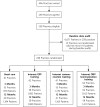Antibiotic Prescribing for Acute Respiratory Tract Infections 12 Months After Communication and CRP Training: A Randomized Trial
- PMID: 30858255
- PMCID: PMC6411389
- DOI: 10.1370/afm.2356
Antibiotic Prescribing for Acute Respiratory Tract Infections 12 Months After Communication and CRP Training: A Randomized Trial
Abstract
Purpose: C-reactive-protein (CRP) is useful for diagnosis of lower respiratory tract infections (RTIs). A large international trial documented that Internet-based training in CRP point-of-care testing, in enhanced communication skills, or both reduced antibiotic prescribing at 3 months, with risk ratios (RRs) of 0.68, 0.53, 0.38, respectively. We report the longer-term impact in this trial.
Methods: A total of 246 general practices in 6 countries were cluster-randomized to usual care, Internet-based training on CRP point-of-care testing, Internet-based training on enhanced communication skills and interactive booklet, or both interventions combined. The main outcome was antibiotic prescribing for RTIs after 12 months.
Results: Of 228 practices providing 3-month data, 74% provided 12-month data, with no demonstrable attrition bias. Between 3 months and 12 months, prescribing for RTIs decreased with usual care (from 58% to 51%), but increased with CRP training (from 35% to 43%) and with both interventions combined (from 32% to 45%); at 12 months, the adjusted RRs compared with usual care were 0.75 (95% CI, 0.51-1.00) and 0.70 (95% CI, 0.49-0.93), respectively. Between 3 months and 12 months, the reduction in prescribing with communication training was maintained (41% and 40%, with an RR at 12 months of 0.70 [95% CI, 0.49-0.94]). Although materials were provided for free, clinicians seldom used booklets and rarely used CRP point-of-care testing. Communication training, but not CRP training, remained efficacious for reducing prescribing for lower RTIs (RR = 0.7195% CI, 0.45-0.99, and RR = 0.76; 95% CI, 0.47-1.06, respectively), whereas both remained efficacious for reducing prescribing for upper RTIs (RR = 0.60; 95% CI, 0.37-0.94, and RR = 0.58; 95% CI, 0.36-0.92, respectively).
Conclusions: Internet-based training in enhanced communication skills remains effective in the longer term for reducing antibiotic prescribing. The early improvement seen with CRP training wanes, and this training becomes ineffective for lower RTIs, the only current indication for using CRP testing.
Keywords: C-reactive protein; antibiotics; antimicrobial resistance; antimicrobial stewardship; clinical practice patterns; communication; practice-based research; prescribing; primary care; respiratory tract infections.
© 2019 Annals of Family Medicine, Inc.
Figures
References
-
- Akkerman AE, van der Wouden JC, Kuyvenhoven MM, Dieleman JP, Verheij TJ. Antibiotic prescribing for respiratory tract infections in Dutch primary care in relation to patient age and clinical entities. J Antimicrob Chemother. 2004; 54(6): 1116–1121. - PubMed
-
- Kroening-Roche JC, Soroudi A, Castillo EM, Vilke GM. Antibiotic and bronchodilator prescribing for acute bronchitis in the emergency department. J Emerg Med. 2012; 43(2): 221–227. - PubMed
-
- Smith S, Fahey T, Smucny J, Becker LA. Antibiotics for acute bronchitis. Cochrane Database Syst Rev. 2014; 1(3): CD000245. - PubMed
Publication types
MeSH terms
Substances
Associated data
LinkOut - more resources
Full Text Sources
Medical
Research Materials
Miscellaneous

